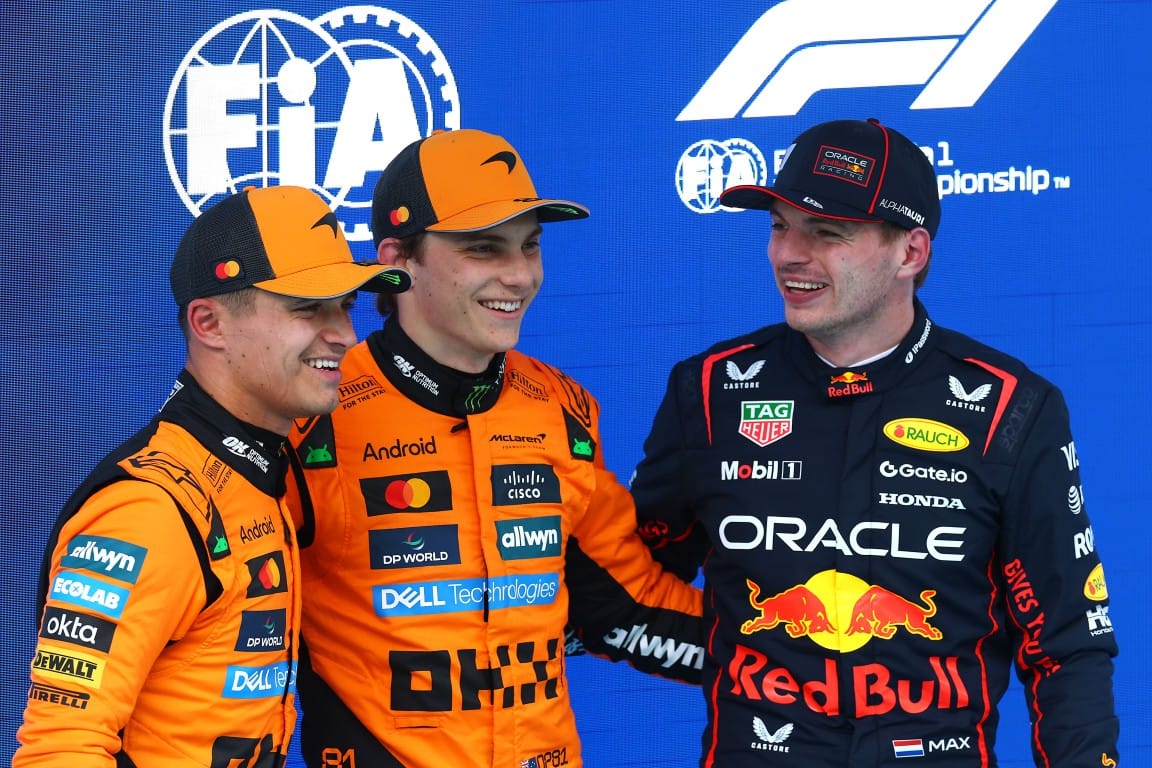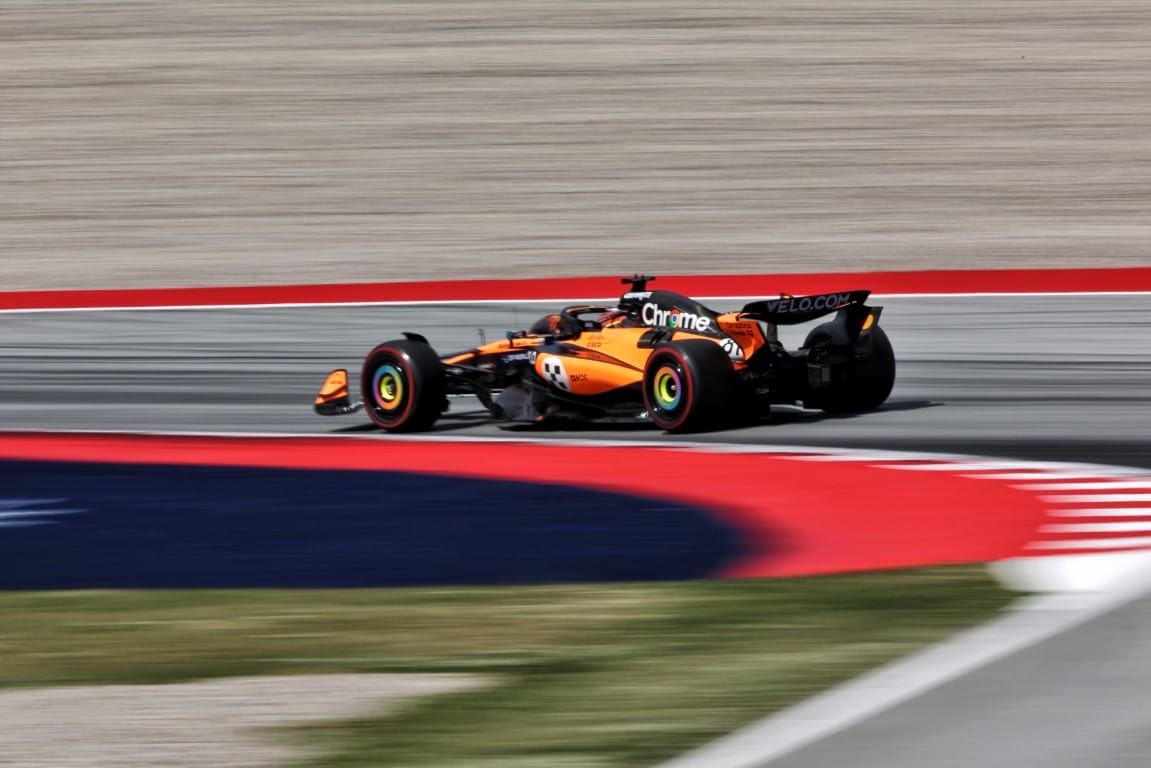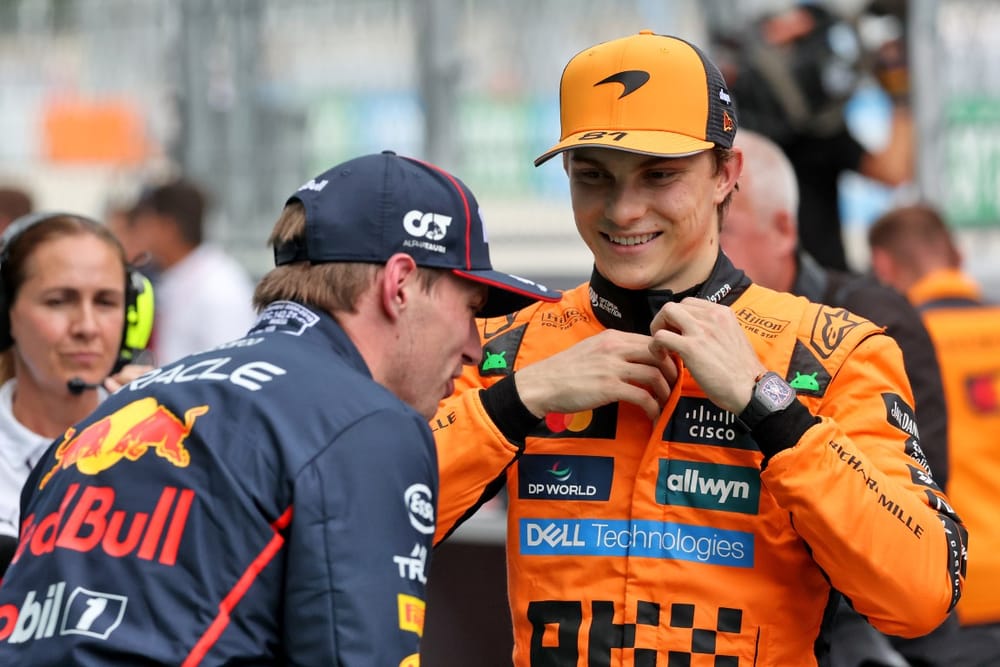“For us the change was always very small, I don’t know about the others,” said McLaren Formula 1 team principal Andrea Stella after seeing his cars lock out the Spanish Grand Prix front row, Oscar Piastri from Lando Norris.
He was talking of course about the new restrictions on front wing flexibility, which take effect from this weekend. He resisted any temptation to say ‘I told you so’, but he would have been fully justified in saying exactly that.
Red Bull, which pushed hard behind the scenes for such a clampdown and arrived here with a new front wing reprofiled to optimise the newly-restricted flex, qualified third with Max Verstappen, but with a chunky deficit of over 0.3s to Piastri’s pole.
Here’s how that compares with Red Bull’s qualifying form in the full flex part of the season to date.
Red Bull qualifying lap % relative to pole
Japan/Saudi/Miami 100%
China sprint 100.02%
Imola 100.05%
China GP 100.19%
Miami sprint 100.30%
Spain 100.42%
Australia 100.50%
Bahrain 100.65%
Monaco 101.02%
As can be seen, the Spain performance is at the less competitive end of ‘normal’ for the car in the season to date. Verstappen explained that his main difficulty was Turn 1 and having the tyres ready for that first turn while still taking the outlap easy enough that the rears weren’t too far over-temperature by the end of the push lap.
He was 17 metres earlier on the brakes into that turn than Piastri, and his mid-corner minimum was 10kph slower. That’s where McLaren really did the damage.
Might that be a function of the less flexible wings? With the greater front wing angle a flexi-wing would have enabled, maybe it would have worked the tyres just past that temperature threshold which switches them on. It’s an imponderable, of course, but around two-thirds of Verstappen’s shortfall to Piastri came in the first sector. He then lost a further 0.12s through the twists of sector 2 (Turns 4 to 10) before clawing 0.027s back through the final sector.

The McLaren was just a more sweetly-balanced car through the lap – though, just like every other car, possibly not quite as much so as before. The drivers do seem to be working harder, the consensus among them being that the cars are now more oversteery in the fast corners. But Stella emphasises that, for McLaren at least, his team doesn't see any significant difference.
“When you have less aero elastic effect you’ll have a slightly more pointy car in high-speed and slightly more understeery in low-speed. But looking at the numbers it’s so small it’s almost within the noise of variation from one lap to another. We tried the new wing briefly on Lando’s car in practice at Imola and if we hadn’t have told him it was a different wing, he would not have noticed the difference.”
Putting aside the traits of the cars in general, the competitive comparison looks perfectly 2025 standard issue. Yes, the RB21 has not shone as brightly here as around those other quick corner tracks Suzuka and Imola. But Stella, at least, does not assign this to the new wing regs.
“Yes, I was a little surprised that we had such a clear advantage, as I’d expected Red Bull to be a little closer based on some of the similar circuit characteristics we found at those tracks.
"But in hindsight I think the very high temperatures associated with the rear axle - and that’s where our car performs very well. One characteristic of Spain is that the corners are very long - unlike Imola, where they are short.
"In these long corners the MCL39 carries over some of the qualities of its predecessor, which you saw in long-corner circuits like Zandvoort, where Lando was dominant.
"Even if the speed range of the track was similar to others where Red Bull have been very strong, the length of the corners helped us today.”
In other words, any variation in the gap between McLaren and Red Bull – pre-tech directive to now - was almost certainly just the normal ebb and flow of how circuit characteristics dovetailed with car traits and not the tech directive itself.
In fact, Red Bull believes the flex restriction has made its job of pulling the RB21’s set-up together easier. This much was suggested by how untypically well-balanced it was for a Friday here. But there was no big overnight gain, as has so often happened this season.
So Red Bull’s hopes would now seem to be pinned on some Verstappen Imola-like first-lap magic (which George Russell managed here from third on the grid last year) and/or better tyre deg in the race. Verstappen was marginally the fastest in Friday’s long runs, so that’s not an impossible prospect, and with this set to be a two-stop race there are many strategic possibilities.
How Piastri beat Norris

Impressive though Piastri’s gap over Verstappen was, perhaps it’s the gap to second-fastest Norris in the same car which is yet more so, at 0.209s. It all came on their final Q3 runs, with the track at its quickest.
Norris had a slide through Turns 1-2 - which didn’t cost him much time immediately but which got those rear tyres a little hotter than ideal for the twists which follow – and he was 0.15s down to Piastri through that middle sector. That’s where Piastri won pole.
“I had to tidy up a few corners from my first Q3 run,” he said, “and maybe I got a bit too excited in the second half of the lap. That latter part a reference to him being only fourth-fastest through S3 behind Verstappen, Norris and Russell.
Russell equalled Verstappen’s time. The Mercedes is quick over a single lap here but on Friday still looked prone to overheating its rear tyres.
The Ferrari’s performance profile here appears to be the opposite and Charles Leclerc has tried to fully exploit its promising race pace by saving an extra set of medium tyres. So he’ll likely by on mediums as others have switched to the slower hards (which is not a well-balanced tyre between front and rear and relatively slow).
This cost Leclerc a second set of softs for Q3 and, making only one run, he was outqualified by team-mate Lewis Hamilton for the first time since China, with Lewis starting P5, two ahead of Leclerc, Kimi Antonelli’s Mercedes between them.
Unless there is some twist in the tale on race day, the wing flex rethink has made somewhere between zero and insignificant difference to the competitive landscape.



